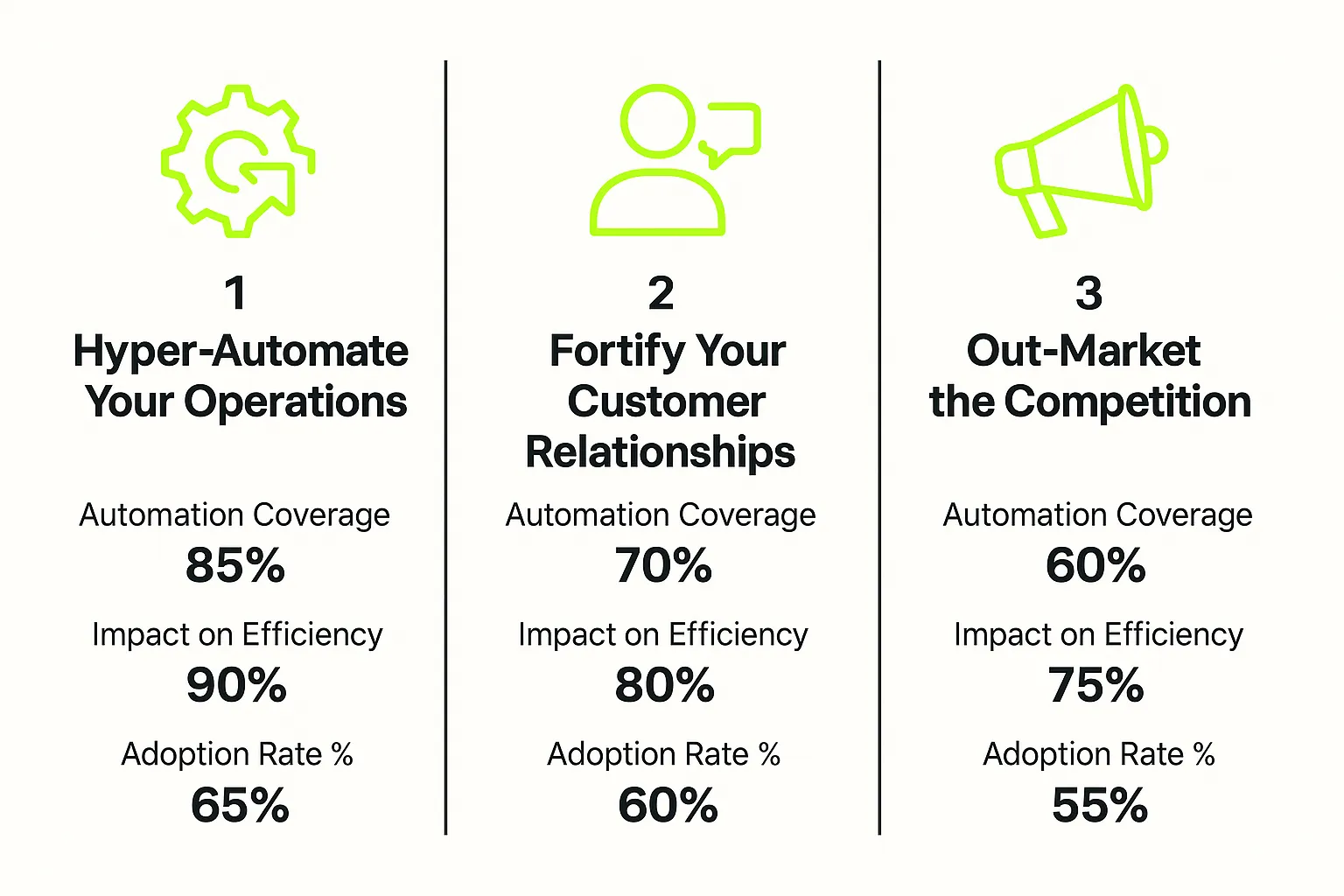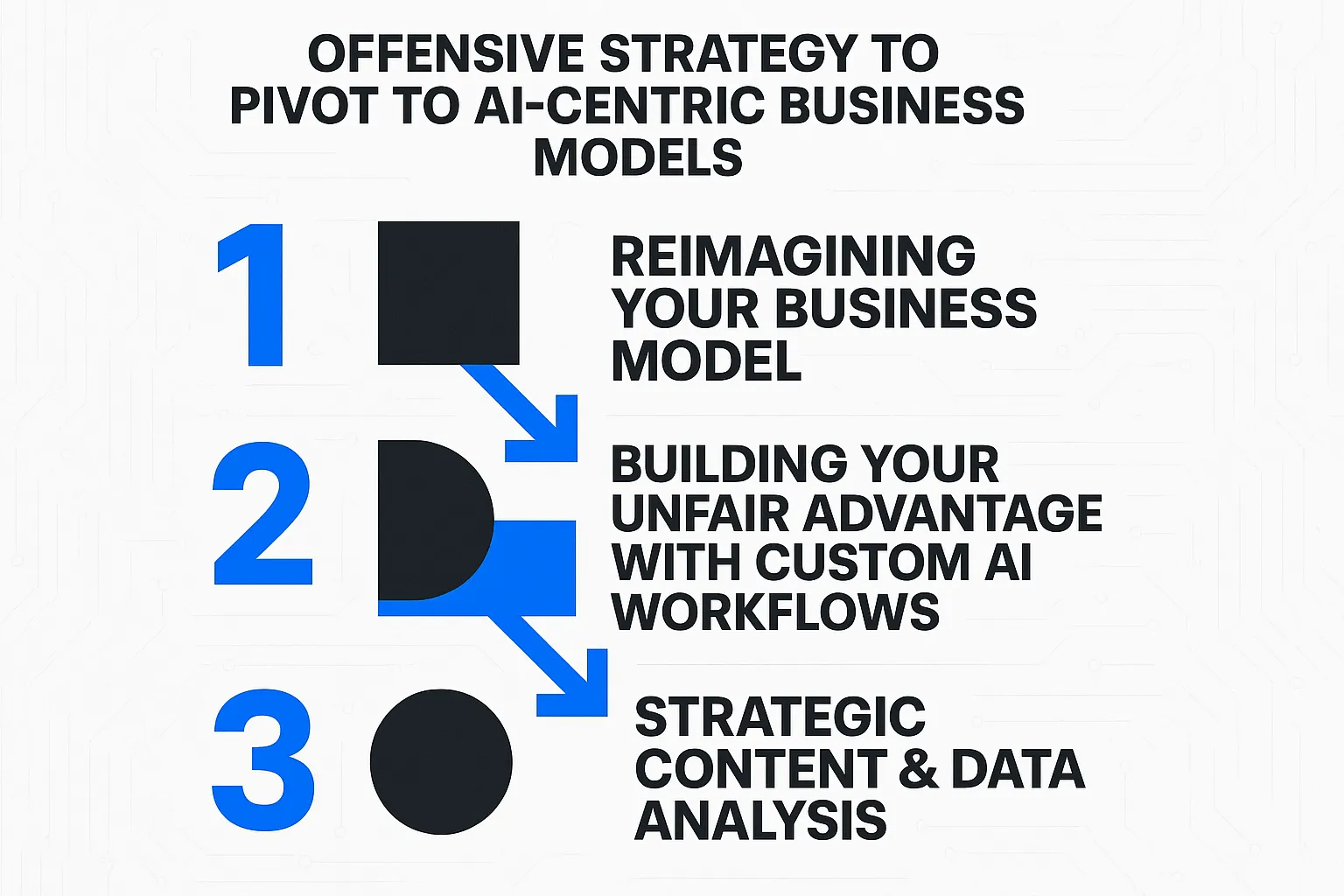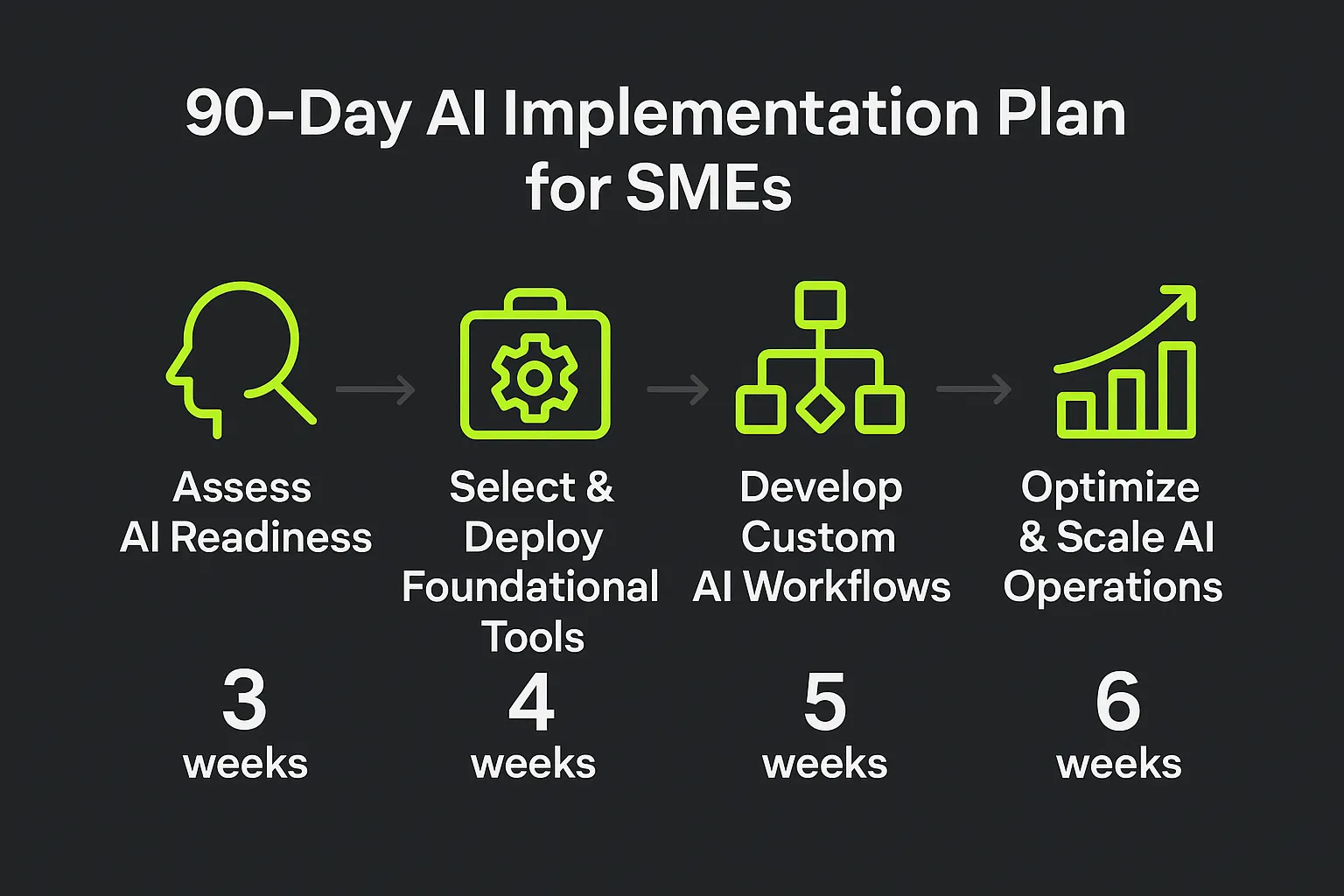Proactive Survival: A Guide to Defending Against AI-Native Competitors
AI Summary
Proactive Survival offers a practical plan to defend your business against AI-native competitors by integrating AI strategically for growth and resilience.
- Who:
Small and medium businesses facing AI-native competition - What:
Building AI-powered defenses and offensive strategies to compete - When:
Starting immediately with a 90-day implementation plan - Where:
Markets disrupted by rapidly evolving AI-native competitors - Why:
To increase efficiency, safeguard customers, and create a competitive advantage using AI-driven workflows and insights
You started by searching for a list of AI tools. It’s a logical first step. But the real question you’re asking isn’t about tools. It’s about survival. You see new competitors entering your market, moving faster and operating leaner than seems possible, and you’re wondering if you’re being left behind.
You’re not alone. In 2024, an estimated 40% of U.S. small businesses were already using generative AI, a figure that nearly doubled from just 23% in 2023. This isn't a trend. It's a fundamental shift in the competitive landscape. Your search for tools is the right instinct, but it's only the first step in a much larger strategy. This guide will give you the battle plan you need, moving beyond simple tools to build a resilient, AI-powered business that can thrive.
The New Battlefield: Identifying AI-Native Threats
Before you can build a defense, you must understand the threat. An AI-native competitor isn't just a business that uses AI tools. It's a business built from the ground up on an AI foundation. They operate with a completely different set of rules.
Their advantages are clear:
- Unprecedented Speed: They can develop products, launch marketing campaigns, and analyze market feedback in days, not months.
- Extreme Cost Efficiency: Automation handles what once required entire teams, allowing them to offer competitive pricing while maintaining healthy margins.
- Data-Driven Decisions: They don't guess what customers want. They use AI to analyze data and predict market needs with unnerving accuracy.
How do you spot them in your industry? Look for new entrants with pricing that seems unsustainably low or companies that consistently release new features and content at a pace your team can't match. These are the early warning signs that the ground is shifting beneath your feet.
Phase 1: Building Your Defense with Foundational AI
Your first move is to fortify your current operations. This isn't about chasing every new tool. It's about strategically implementing foundational AI to make your business more efficient, resilient, and customer-focused. The goal is to free up your team's time from repetitive tasks so they can focus on strategic growth. Research from Salesforce confirms this approach works, as 91% of SMBs who adopt AI report a boost in their revenue.
Let's organize your defense into three core areas.
Hyper-Automate Your Operations
Start with the engine room of your business. This is about automating the repetitive, time-consuming tasks that drain resources. AI can handle scheduling, invoicing, data entry, and project management, creating a more efficient operational backbone. For e-commerce businesses, this translates directly to the bottom line, with 69% seeing better operational efficiency after AI implementation.
Fortify Your Customer Relationships
Your existing customer base is your most valuable asset. AI can help you protect it. AI-powered CRMs can analyze customer interactions to identify upsell opportunities or flag at-risk clients. Intelligent chatbots can provide instant, 24/7 support, answering common questions and freeing up your human agents to handle complex issues. The impact is significant, with 95% of businesses reporting improved quality in customer service responses after adopting AI.
Out-Market the Competition
AI levels the playing field in marketing. Tools now exist to help you generate high-quality content ideas, optimize your website for search engines, and manage ad campaigns more effectively. By automating parts of the creative and analytical process, you can produce more strategic content that speaks directly to your audience's needs, helping you build trust and authority. The key is to create content that demonstrates expertise and answers user questions better than anyone else, which is essential for building trust and credibility in the era of AI.

Phase 2: Your Offensive Strategy - Pivoting to an AI-Centric Model
Defense buys you time. Offense wins you the market. Once your foundational AI is in place, it's time to pivot from using AI as a simple tool to integrating it into the core of your business strategy. This is how you move from surviving to dominating.
Reimagining Your Business Model, Not Just Your Tasks
Ask yourself a bigger question: How can AI change what my business offers? Instead of just using AI to write emails faster, consider how it could enable a new, personalized service for your clients. Instead of using it for accounting, think about how it could power a predictive financial advisory product. This is the shift from incremental efficiency to transformational growth.
Building Your Unfair Advantage with Custom AI Workflows
The real power of AI emerges when you connect different tools to create a proprietary system tailored to your unique business process. A generic chatbot is a commodity. A chatbot connected to your CRM, inventory system, and marketing platform becomes a custom workflow that provides a seamless customer experience your competitors can't easily replicate. This is where you create a true competitive moat.
Strategic Content and Data Dominance
With a solid operational and strategic foundation, you can turn your attention to market intelligence. Use AI to analyze competitor strategies, identify underserved customer niches, and predict market trends. This allows you to create highly targeted content and offers that capture market share before others even know the opportunity exists. You'll need to know which tools for analyzing expert content impact on AI brand authority can provide the deepest insights to guide your strategy.

Your First 90 Days: An Actionable Implementation Plan
Thinking about AI transformation can feel overwhelming. The primary barriers for most businesses are education and awareness, not cost. A clear plan removes the uncertainty. Here is a practical 90-day roadmap to get you started.
- Days 1-30: Assess and Automate. Identify the single biggest time-consuming, repetitive task in your business. Select and deploy one foundational AI tool to automate it. The goal is a quick win that demonstrates value and builds momentum.
- Days 31-60: Connect and Customize. Build your first simple, custom workflow. Connect two of your systems, such as your lead capture form and your AI-powered CRM, to automate lead qualification and follow-up.
- Days 61-90: Analyze and Attack. Use an AI tool to analyze your market. Identify one keyword or topic your competitors are ignoring. Launch a targeted content campaign to capture that niche audience.

From Defense to Dominance with the Right Partner
The journey from feeling threatened by AI to leveraging it for market dominance is a strategic one. It begins with building a solid defense through smart automation and culminates in an offensive strategy built on custom, data-driven workflows.
You don't have to navigate this transformation alone. A dedicated AI transformation partner can help you implement simple, automated systems that deliver results quickly, allowing you to scale your business without scaling your team. The goal is to build your capabilities, not just sell you software.
Frequently Asked Questions
Is this going to be too expensive for a small business?
The focus should be on return on investment, not just cost. With 91% of SMBs seeing revenue boosts from AI, the cost of inaction is often higher than the cost of adoption. You can start with low-cost foundational tools and scale your investment as you see positive returns.
We're not tech experts. How complex is this to implement?
Many of today's AI tools are designed with user-friendly interfaces. The key is to start simple. For more complex integrations and custom workflows, an expert partner can handle the technical lift, providing you with a system that just works without you needing to become a developer.
How can we find the time for this when we're already so busy?
Start with the task that is currently consuming the most time. A small initial time investment in automating that single process can free up dozens of hours per month. That reclaimed time can then be reinvested into further AI implementation.
Will AI replace my team?
AI is a tool to augment your team, not replace it. It excels at handling repetitive, data-heavy tasks. This frees your people to focus on the high-value work that humans do best: strategic thinking, building client relationships, and creative problem-solving.


